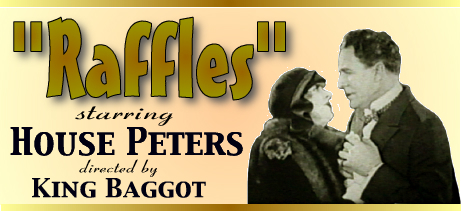

The American "Picture Play" of October, 1925, remarked, "'Raffles' . . . . House Peters is not dashing enough in this story of a crook. In fact, the whole picture is too slow.
". . . and it must indeed be admitted that the film is painfully weak, which, having in mind the famous character and the previous successes of the director, star, and scenario-writer, is at first puzzling. But the answer undoubtedly lies in the fact that a wrong angle of approach has been taken in trying to keep to the spirit of the E.W. Hornung satire whilst failing to allow for the fact that they are told by Bunny, whereas the film shows them from the point of view of a third party. Thus, both scenarist and director have erred in stressing touches such as (quoting the novel) . . .
"'So, it's a case of common pot-hunting," remarked Raffles, eyeing me shrewdly through the cigarette smoke.' Or . . .
"'Capital!" cried Raffles, throwing coils of smoke between his smiles.'"
House Peters struggles valiantly with such gestures, but
the effect is not satisfactory, affectation being portrayed rather
than nonchalance. Moreover, calculated gestures 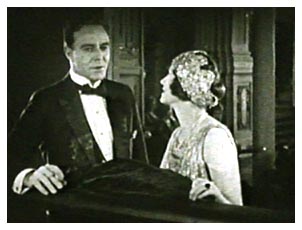 occupy
footage to the exclusion of action, and indeed the screen is often
full of people standing about doing nothing of particular interest.
occupy
footage to the exclusion of action, and indeed the screen is often
full of people standing about doing nothing of particular interest.
That the love theme is trite and rather ludicrous, and the ending a terrific anti-climax, are all the more remarkable when one considers that the scenarist (Harvey Thew) was responsible for the sprightly and dashing Reginald Denny comedies (e.g. "Oh, Doctor"), and that director King Baggot also had to his credit such vigorous action-drama as "The Kentucky Derby" (1922, Reginald Denny) and "The Tornado" (1924, House Peters).
One can only assume that their abject failure to infuse any trace of dramatic action or suspense into this version of "Raffles" was due to an obsession with characterization, and the foolish choice of two of the most uncinematic of Raffles' adventures as the basis of their picture. King Baggot was famous also as an actor, chiefly prior to 1923. He played all types and did particularly well in the heavy comedy part of Fred Smith in "The Girl in the Taxi" (F.N., 1921, by Lloyd Ingraham, starring Mr. and Mrs. Carter de Haven). He is also recalled, with E.E. Horton and Francis X. Bushman, in James Cruze's "Once a Gentleman" (1930). He actually started in 1909 in Carl Laemmle's I.M.P. Company.
"Raffles" moved in excellent company. Released the same week were "Romola" (by Henry King with Lillian and Dorothy Gish), "The Sea Hawk" (by Frank Lloyd with Milton Sills, Wallace Beery), as well as a Clara Bow and a Bebe Daniels feature.
The brief treatment is as follows:
Nonchalant Raffles, drinking, gambling Bunny, and vamping Clarice are introduced on board ship, bound for Tilbury. Raffles steals a necklace, eludes the search, and returns it - the reward to be paid to charity.
Bunny drags Raffles to weekend with Lord Amersteth, where they meet Clarice again, also Bedford, a criminologist who is after "the Amateur Cracksman." Bunny proposes to Lady Gwen, but is turned down. Raffles pleads for him but Gwen thinks he is proposing, and she likes it. Lord Amersteth demonstrates his burglar alarm which lights up the whole garden. Crawshay, a "Cockney" crook, uses the housemaid to steal Lady Amersteth's pearls, but Raffles intervenes and grabs them himself, and captures Crawshay. Bedford ridicules this capture, and wagers Raffles he will recover the pearls by eleven o'clock next evening, and they both arrange to leave for London early next morning. Clarice, seeing Gwen's reaction to Raffles, tips off Lord Amersteth that he is the Amateur Cracksman.
Raffles leaves a phony letter for Bunny to read, explaining to Gwen that he is the Cracksman. Bunny swallows the bait and tells Bedford, thus freeing Raffles of any obligation to him regarding Gwen.
Acting on Bunny's information, Bedford releases Crawshay and has him trailed as he goes to Raffles' rooms after the pearls. Gwen comes to warn Raffles that Clarice exposed him, and has to be hidden when Crawshay breaks in. Raffles outwits Crawshay and sends him off but simulates having been tied up. He is found thus as Bedford enters with the police. Then, it being eleven o'clock, he claims he's won the wager, and, via secret doors, he eludes Bedford and escapes with Gwen.
Scotland Yard admits having nothing against Raffles as he always returned what he "stole." Raffles and Gwen are sped on their honeymoon by a forgiving cable from Lord Amersteth.
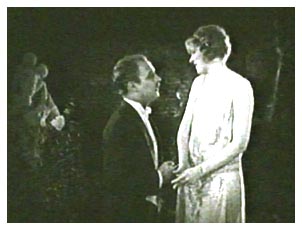 A glance a the verbs in this treatment
will indicate its uncinematic nature: proposes, pleads, ridicules,
wagers, arrange to leave, tips off, etc., involve dialogue titles
and are the danger lights in a silent film script. Compare "The
Lighthouse by the Sea," in whose treatment only two verbs
(insist and advise) denote other than positive pictorial action.
The next point about the narrative is that it lacks background
interest. There is a reel set on board ship (three sets), two
reels in the mansion (huge hall, billiard room, bedroom, and three
exteriors that simply reek of the studio), and finally two reels
in Raffles' London rooms. Except to the very innocent, this arrangement
yells "Stage Play."
A glance a the verbs in this treatment
will indicate its uncinematic nature: proposes, pleads, ridicules,
wagers, arrange to leave, tips off, etc., involve dialogue titles
and are the danger lights in a silent film script. Compare "The
Lighthouse by the Sea," in whose treatment only two verbs
(insist and advise) denote other than positive pictorial action.
The next point about the narrative is that it lacks background
interest. There is a reel set on board ship (three sets), two
reels in the mansion (huge hall, billiard room, bedroom, and three
exteriors that simply reek of the studio), and finally two reels
in Raffles' London rooms. Except to the very innocent, this arrangement
yells "Stage Play."
Again, the narrative has no proper modulation, no gradual rise in pitch up to a defined climax. It just jogs along at approximately constant measure till it fizzles out in the anti-climax. Finally, there exist discrepancies between the book characters and the screen characters which, though essential for censorship and other reasons, militate against acceptance of the screen narrative. Thus, it is understood that Bunny knows Raffles is the Amateur Cracksman, whereas here he "discovers" it late in the film. Also, Raffles always in fact lived on the proceeds of his "borrowings" even though the surplus went to charity.
It must also be recorded that here is a case of cheating in the screen story. How Raffles achieved the first (necklace) theft is not shown, nor even suggested. This is the last resort of the barren author. A similar case occurred in the English film "Pimpernel Smith" where a shot of blood dripping from a "scarecrow" was supposed to explain just how Smith organized and carried out a large-scale escape. Such actions are the key actions of melodrama, and they must be fully shown or fully suggested, otherwise the very foundation of the tale has gone and the author (or director) has broken faith with his audience. The exception is, of course, the case where mysteries occur and are only explained (but fully explained) at the end.
According to the custom of Universal Pictures, the leading parts are introduced with pattern-background titles bearing the player's name. Some of the titles are set in an inferior type, different from the majority. These are the ones that have been specially prepared for the English version, due to spelling and dialogue peculiarities.
The film opens, after a redundant prologue, with a fine long shot of a dance on board ship. News is received of the Amateur Cracksman's latest exploit. Then Raffles, laughing lightly, crumples the newssheet and tosses it into the wake. Bunny joins him, and admits having passed a bad cheque. They walk a few yards along the deck, and two remarkable things happen. Raffles suddenly is smoking, and the camera becomes unsteady - and we realize the cameraman has recalled he's aboard ship and is futilely attempting to portray the ship's motion. Raffles silently hands Bunny a wad of notes. This action is somehow "what would not be one by a gentleman and a cricketer." It is also puzzling that Raffles should wear a dinner jacket against Bunny's tails, as they are specified as intimate friends. Cumulatively these snags are disheartening.
Clarice next joins Raffles on the deck, and starts a laboured conversation that is interrupted by an elderly couple showing the news sheet to Raffles who warns the lady to be careful with her necklace.
Two more continuity titles and mid-shots introduce first
two dusky gentlemen of India (a pointless red-herring) and, second,
Bunny gambling again. In background, Raffles watches through window.
Then . . .
1. L.S. Group talking, including lady with necklace
2. C.S. She talks . . .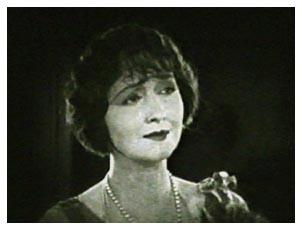
3. C.M.S. (at a window) Raffles looks . . .
4. C.S. She talks, fingers necklace . ..
5. C.M.S. (at window)Raffles looks. . .
6. M.S. A gent remarks to one of the Indians . . .
7. TITLE "They say Mrs. Tilliston wears the famous Rajah
necklace tonight."
8. M.S. (as 6)
9. C.S. (as 2 and 4) a shadow of a hand appears on the wall behind
her and suddenly the necklace is whipped away. She yells.
Then a mild commotion follows, and Raffles wanders up smoking like a chimney, and remarks to Clarice who has eyed him menacingly, "There appears to have been a jewel robbery."
The grand search at Tilbury includes Mr. Tilliston, who is vastly indignant (the one good bit of comic relief) but is soothed by Raffles' present of a box of cigarettes. A very nicely done double mix shows the necklace hidden behind the cigarettes, together with a note directing payment of the reward to charity. So, neatly, Mr. T. walks off the ship carrying his wife's diamonds.
Raffles' London rooms are beautifully reproduced in an excellent set, impeccably lit in the "all-over" style and quite free from high spots which is an achievement when the set walls are polished oak paneling. We also see the landing with a splash of sunshine as Bunny calls and enters. After some painfully redundant titles, they decide to weekend with Lord Amersteth.
A full long shot shows the fine old hall and a close mid-shot
of Lady Amersteth with Clarice on a sofa follows. They are seated
near together but in their individual medium close-ups, each is
obviously alone - a disconcerting error of camera angle. Then,
unbelievably horrible:
1. L.S. (exterior garden, night) (gauze, black vignette) Raffles
and girl . . .
2. M.S. They stand talking . . .
3. TITLE LADY GWENDOLYN AMERSTETH -- . . . Miss Du Pont
4. C.S. She looks up coyly and says . . .
5. TITLE "How strange! I never saw you until yesterday, yet
I feel I've known you always."
6. C.S. She says.
7. C.S. Raffles expels smoke and replies . . .
8. TITLE "Friendship isn't a question of time but of understanding,
Lady Gwendolyn."
The nighttime exterior lighting is fairly good, but the
available prints are tinted amber throughout, whereas these sequences
should be blue. The gauze softening is not well done. There is
halation. Better lit is the exterior of the front of the house,
as Bedford is driven up (in the famous Hollywood Rolls Royce).
Within, Lord Amersteth greets him. The glimpses of the porch and
stairs are good. The atmosphere of the house is well portrayed.
Bedford states the Cracksman is to be expected. Bunny sends Raffles
into the house, and is left alone with Gwen and a Cupid statue.
Raffles mocks Bedford in a lengthy subtitular conversation, till
Amersteth suggests billiards. Meanwhile amid different statues,
Bunny is turned down by Gwen. Much footage is then devoted to
Clarice sparring with Raffles in the billiards room. Lady Amersteth
taking off her pearls and retiring and Lord Amersteth demonstrating
his burglar-proof safe, with comments about danger, the possibility
of the Cracksman being actually 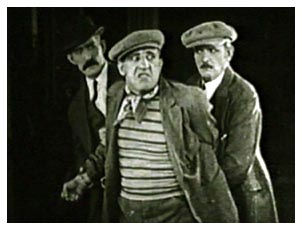 present
in the room, and so on. His Lordship duly puts in the necklace
box.
present
in the room, and so on. His Lordship duly puts in the necklace
box.
Meanwhile a crook climbs over the garden wall and remarks to the housemaid, who meets him, "You git der pearls - I'll do der rest." (The queer dialect was done for the English version). Lord Amersteth demonstrates the alarm. The whole estate is lit up. All rush into the hall. Raffles wagers Bedford he will not capture the Cracksman. The whole is slow and painfully over-titled, though there are one or two good reaction close-ups, particularly from Hedda Hopper whose portrayal of Clarice has nice touches of comedy and sly smiles.
Bunny gnaws his lip and drinks whiskey. Raffles smokes furiously, and in more titles it is decided that Raffles will "put in a word" with Gwen if Bunny stops drinking. Raffles therefore hails Gwen as the two girls are going up stairs. And in a ghastly mid-shot, Gwen smiles brightly while Clarice looks grim. And, in a pleasing angle-shot looking down the stairs, Clarice goes up alone. Meanwhile, by match light, Bedford closely examines the cigarette end left by Raffles after his recent talk with Bunny. But the shot is quite incomprehensible at the first viewing of the film, being insufficiently explicit.
Back in the studio garden Raffles cuts Gwen a studio rose, which she carefully smells. He pleads for Bunny in medium close-ups taken from his right side but nearly full face. She listens in nicely-lit diffused close-ups, also nearly full face but taken from her right side, also -- a curious technical lapse which does not always matter. In this case gives the strong impression that they are looking in the same direction instead of at each other. The sequence is 52 feet long (that is 1 3/4 minutes, having been shot at 20 frames per second) and contains five titles. Miss Du Pont's eye work in the last close-up is truly horrible. This actress's complete failure to portray a likely Lady Gwen is bewildering. She had the good fortune to play opposite Erich von Stroheim in "Foolish Wives" in 1921, and late that year was boosted enormously by Universal as their new discovery. Stroheim's direction was painstaking, detailed, impressive. An article in the "Motion Picture Classic" of October, 1921, entitled, "A Million Dollar Miss" ends thus . . .
"Miss Du Pont is going to be popular in spite of her name . . .
"'I want to play straight American woman parts,' she said to me, while the assistant director was bribing the gardener not to burn weeds so that the smoke would blow into the scene. 'The American girl is always an interesting person, and if I can put over good, clean, young womanhood in my pictures, and do it convincingly, I will be happy.'"
She made a few starring vehicles then dropped to featured parts as in "Raffles" . . . yet another case of a great director drawing a fine performance from a player who is later found wanting without his guidance.
In a short sequence containing quite a nice-but-pointless mirror shot, Clarice warns Lady Amersteth, who is having a mud-pack treatment. These details are presumably intended to add production value, but they distract. Gwen trips upstairs, tossing Raffles her rose - and in a medium close-up, he acts the dawning of Gwen's thoughts in his mind very well indeed. Then Bedford strolls up, and he waves the rose with charming, studied nonchalance.
Briefly and efficiently we are next shown, all in long shots,
the crook climbing over the wall. The maid stealing something
from under Lady Amersteth's pillow, and Bedford falling asleep.
But by a pure coincidence, which weakens the credibility of his
great reputation, Raffles sees the crook and follows him in and
catches the pearls as they are dropped over the banisters. Here
the action is good but the lighting all wrong. The window is absurdly
bright, and the direction of the strong shaft of light that 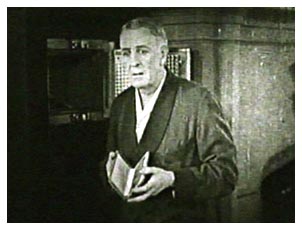 enters the doorway varies in direction and
brilliance between long shot and mid-shot, and later completely
disappears.
enters the doorway varies in direction and
brilliance between long shot and mid-shot, and later completely
disappears.
Excellent dramatic counterpoint has been achieved between Bedford's sneer at Raffles' assurance that the pearls are safe. The discovery by Lady A. that they've gone, and the finding of the empty case intact in the famous safe. Ingeniously, too, the excitement brings the girls out of bed and enables them to show how cute their hair can be, all hanging around them. A really sly smile plays round Clarice's lips, in her close-up glance at Raffles. The sequence fizzles out in titles as Bedford wagers he'll recover the pearls and they both arrange to leave early for London.
Confusingly early next morning, it is Clarice who leaves by car, after an absurd struggle by the chauffeur with his hand brake. Why this ridiculous shot was not retaken is baffling. Unless this was the second take, used for the export copy negative. The men must have left even earlier, we gather, because we next see Raffles and Bunny in London. Raffles has started a letter to Gwen which reveals his feelings to her, and Bunny enters and reads it. It is not made clear whether the letter was left deliberately (as stated in the treatment), but that Raffles should leave so intimate a note and should also fail to prevent Bunny seeing it are quite unthinkable. But the director has erred again in permitting his confusion.
A neat angle shot through the leaded window show two police blokes watching outside. Bunny goes and spills the beans to Bedford in his office. As in Raffles' rooms, the glimpses of London through the windows are good, and well-lit.
Crawshay enters via a roof-top set, which is excellent, with its background of Big Ben, and smoking chimney pot in the foreground and traces of fog, but marred by the facts that the beam from the studio lights can be seen at the right side, and that Crawshay casts a shadow on the backdrop.
Plainclothes men report the entry by phone and a cutting error occurs as they speak again after Bedford has hung up. He glances at his watch. . . C.S. watch shows a quarter to eleven. At least six frames too many are left before the C.S. starts, a typical example of the too-leisurely cutting.
Gwen's unexpected arrival, the inevitable "I believe in you --" and embrace, and her concealment as Crawshay arrives, are stolidly shown. There could easily have been a moment of suspense, or some trace of subtlety, but these factors are conspicuously absent. Crawshay demands the return of the pearls, and accidentally finds Raffles' pistol and threatens him, but is caused to drop it by an eloquent speech about death sentences. The number of titles in this sequence is frightening.
 Shots of bewildered Gwen in the
cupboard are cut in as Raffles disorders the room and binds himself
and sends Crawshay away. Bedford and his men first rattle the
door handle, then quite easily open the door and walk in - another
stupid weakness. Raffles acts dizzy and plays out time till eleven
o'clock. Then he claims his wager, fools Bedford by a simple trick
of going to the inner room to pack a few clothes, which would
not have taken in a ten year-old sleuth, and easily escapes with
Gwen, via secret doors that open and shut at a touch on the paneling.
Even this sequence fizzles out, ending as it does with a note
to Bedford and a phone talk with Lord Amersteth - and again Bedford
hangs up before Lord Amersteth has finished speaking.
Shots of bewildered Gwen in the
cupboard are cut in as Raffles disorders the room and binds himself
and sends Crawshay away. Bedford and his men first rattle the
door handle, then quite easily open the door and walk in - another
stupid weakness. Raffles acts dizzy and plays out time till eleven
o'clock. Then he claims his wager, fools Bedford by a simple trick
of going to the inner room to pack a few clothes, which would
not have taken in a ten year-old sleuth, and easily escapes with
Gwen, via secret doors that open and shut at a touch on the paneling.
Even this sequence fizzles out, ending as it does with a note
to Bedford and a phone talk with Lord Amersteth - and again Bedford
hangs up before Lord Amersteth has finished speaking.
At this point, it will be seen that the film is finished. The Raffles character has been portrayed, and his happy-ever-after with Gwen fully established. However, it runs on for a further four minutes with two sequences. The first, in a room at Scotland Yard, has Amersteth, Bedford, and a superintendent with a letter and five titles, explaining that Raffles was no crook. The second shows the happy couple on board S.S. Olympic receiving a hearty cable from Lord Amersteth and doing a comic gag with a pencil that is simply pathetic.
Consideration of the production phases will throw further light on the causes of this film's unfortunate weaknesses. . .
SCENARIO: As explained above, the adaptation is bad in that characteristics have been altered whilst stressing character touches. Also, the dramatic structure is weak. The number of titles, totaling 180, that is one every 22 seconds on the average, should have warned everyone concerned. Some excuse may be made for he laboured insistence on Raffles' honesty, due to censorship. The narrative suffers also from stray ends - e.g. the housemaid.
DIRECTION: A two-column letter in the American "Motion
Picture Magazine" of July 1923 extols director King Baggot
up to the skies and includes the passage . . . "Every one
of his pictures bears an indelible stamp of sincerity, and his
attention to every minute detail is unsurpassable. King Baggot!"
Here, however, we have to blame 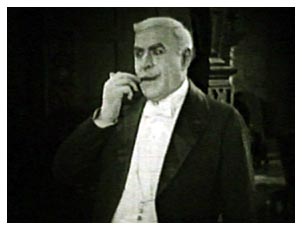 him
for a deathly slowness, for shots of people talking and talking
instead of doing something, for permitting dramatic unbalance,
for extracting from his cast more calculated and stereotyped gestures
than could easily be equaled, and for failing to insert either
thrill (it is a crook picture) or suspense (in the escape). The
Cupid statue symbolism is ghastly, and the crumpling up of the
(studio) roses a silly impossibility.
him
for a deathly slowness, for shots of people talking and talking
instead of doing something, for permitting dramatic unbalance,
for extracting from his cast more calculated and stereotyped gestures
than could easily be equaled, and for failing to insert either
thrill (it is a crook picture) or suspense (in the escape). The
Cupid statue symbolism is ghastly, and the crumpling up of the
(studio) roses a silly impossibility.
CONTINUITY: Such errors as Clarice leaving early when the previous title had led one to expect Raffles and Bedford add to the confusion of a vague scenario and weak direction. Vanishing cigarettes, and Raffles's fire screen, which is flung on its face in a huge close-up, but is still as it was in the following long shot, are pieces of gross carelessness.
PHOTOGRAPHY: Though this is good and efficient in avoiding wrong shadows and giving reasonable "depth" for the most part, the complete lack of any attempt whatsoever at pictorial composition is deplorable. The number of dead centre head-and-shoulder medium close-ups is terrific. The camera is, of course, used entirely objectively. Charles Stumar also did some of the Denny comedies, and "The Cohens and the Kellys" (1926), etc.
ACTING: For a good class American picture, this is, on the whole, unusually bad. No acting moments stick in one's mind except possibly Raffles and the rose, and Clarice's insinuation. Not one of the players ever did anything really "big" on the screen, through Peters played numerous good stellar roles, and Hedda Hopper was a featured player for years. She recently did a nice job as the Aunt in "Reap the Wild Wind." Winter Hall's Lord Amersteth and also Crawshay (Walter Long) are competent and realistic. Hall played Joseph in "Ben Hur" (1926). Walter Long played Gus in "The Birth of a Nation" (1915).
MONTAGE: No attempt at proper shot matching, no inspiration in arrangement even of those reaction close-ups that are well directed, and a hopeless lack of slickness. For an American film, it is incredibly bad.
GENERAL: In analyzing "Raffles," we have taken a film made by an established director for a big company with a good cast and a popular star. That the result should have been so disastrous is due to the facts revealed by dissection of the production phases - and from all this one's store of knowledge is increased just as by the study of a big success. We must sympathise with these good people that their efforts, which were doubtless considerable, yielded so poor a result. And it is remarkable and uncanny that, despite all, one cannot help remembering the film with is fine old house and oak paneling and one or two of its actors with quite considerable affection.
End Note: Sally Dumaux wrote a biography of King Baggot. UCLA has retored another Universal film by Baggot, "The Home Maker," with Alice Joyce and Clive Brook, which is superb. He also directed the fine western with William S. Hart, "Tumbleweeds." All of these films, including "Raffles," were made in 1925. Kate Lester was so severely burned in an accident on this production that she died, and her role was taken over by Mathilde Brundage (Picture Play, May 1925 p. 86). (Kevin Brownlow)